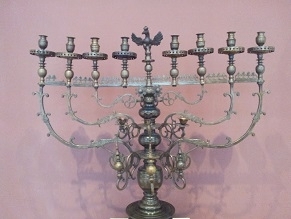|
Euroasian Jewish News

Hanukia from the Museum of Fine Arts in Brussels. Photo credit to: lyonka72.livejournal.com
|
Letter to EAJC President on the program “Description of Jewish cultural objects”
02.04.2018, Region To EAJC President
Mr. Mikhail Mirilashvili
Dear Mr. Mirilashvili,
In the fall of 2017, we presented the Program Commission with a project application concerning the “Description of Jewish cultural objects” program. This project was approved by the EAJC Program Commission, but so far we have not received a formal reply from you on whether it will be financed or not.
This program is part of a larger program for the preservation of Jewish cultural heritage. As part of this program, the EAJC is working to create a series os sub-ethnic museums of the history and culture of Jews from various regions of the former Soviet Union (the EAJC Museum Project). We also describe monuments that belong to Jewish cultural heritage in post-Soviet space, and creating a catalogue of them to create a network of virtual Jewish subethnic museums/ We are working on the following museums: the Museum for the History and Culture of Galicia Jews (Lviv, Ukraine), the Chernivtsi Museum for the History and Culture of Bukovina Jews), the Museum for the History and Culture of Bessarabian Jews (Moldova), and the Museum of History and Culture of Georgian Jews.
Different countries at different times were a part of a number of European and Eurasian monarchies under different political regimes, and thus Jewish cultural heritage in different regions obtained certain characteristic distinguishing marks as it formed under the influence of geopolitical fators and the many centuries that the Jewish Diaspora has existed in the multinational environments of each of the regions. This led to the formation of subethnic distinguishing characteristic, which influenced the mentality, culture, and way of life of Jews of different regions. The Torah remained the main source of Jewsh traditions and customs, but they acquired new elements through different cultures mutually impacting each other, which can be seen through traditions of decorative and applied art, through arthcitecture, and so on.
Objects that belong to Jewish cultural heritage are being conserved in different museums, libraries, archives, often not in the exposition but in the funds, which makes them inacessibel to visitors. Sometimes these objects aren’t even recognized as Jewish. Very often, because of the particular properties of the Judaica collections and because of the absence of museum experts in those areas in each separate museum, the Jewish objects and collections aren’t represented in the necessary volumes in regular expositions, and their descriptions and evaluations in museum records are often superficial. Thus, the objects are often not preserved with due care, and information about them is not often accessible to researchers.
The program “Description of collections of Jewish objects in museums” will allow for the creation of a data base of Jewish cultural objects and, on the basis of that database, the creation of a virtual museum of Judaica, the history and culture of Jews from various CIS regions, which will provide a good foundation for their further study. This program also includes collaboration with museums to study new Judaica objects and collections. For this purpose we invite experts and museum workers to do a new study of an object, during which they fill out a unified document and take quality photographs of the object from several sides.
Describing Judaica objects is also our contribution to preserving the memories of those who perished in the Holocaust or in other cataclysms. This task also serves to prove that the history of Jewish communities in different countries is inextricably bound to the history of the countries themselves.
A detailed description of the project and its budget has been presented to the Israel office of the EAJC.
We would thus like to request that you, our President, come to a final decision on our project and inform us about the fate of our program.
We are very much looking forward to hearing from you.
Respectfully,
Nadezhda Ufimtseva
EAJC “Description of Jewish cultural objects” Program Director
|
